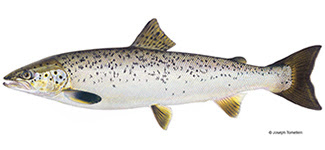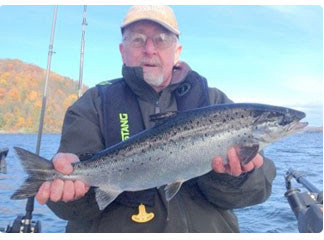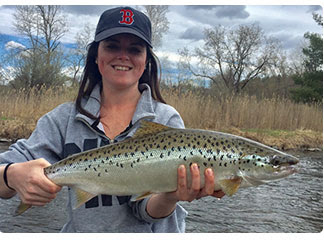Landlocked Atlantic Salmon – Salmo Salar
2019 has been identified as the “International Year of the Salmon” and so this is a great time to profile this native fish species, and Lake Champlain’s salmon restoration program, a collaboration between Vermont Fish & Wildlife, NY Dept. Environmental Conservation, and the US Fish & Wildlife Service.

Atlantic salmon have been in Lake Champlain for 10,000 years, since the Champlain Sea receded and became the freshwater Lake Champlain we know today. Because of its remaining connection to the Atlantic Ocean through the Richelieu and St. Lawrence rivers, sea-run Atlantic salmon would migrate from the ocean to spawn in Lake Champlain’s tributaries. Salmon were so plentiful at one time that historic accounts talk about farmers harvesting them by the hundreds with just pitchforks and baskets. Unfortunately, by 1840, Atlantic salmon had disappeared from Champlain due to the construction of dams that blocked their access to spawning areas, and widespread deforestation which caused erosion, sedimentation, degraded water quality and smothered spawning habitats.
A coordinated effort was initiated in 1972 to restore Lake Champlain’s Atlantic salmon population, and has included stocking, strain assessments, habitat restoration, invasive species control and other research efforts. Recently, for the first time in 150 years, naturally reproduced salmon fry were documented in two Lake Champlain tributaries – the Boquet River NY in 2016 and the Winooski River in 2017. While that’s a remarkable achievement, there’s still a long way to go, but the future looks promising for Lake Champlain salmon and the fishing opportunities they provide.
For more information on landlocked Atlantic salmon restoration efforts in Lake Champlain and the Year of the Salmon, visit Lake Champlain Basin Program - International Year of the Salmon.
Salmon Fishing Opportunities
The fall is a time when shore-bound anglers get a crack at catching a fish species that isn’t normally accessible to them since it’s usually found in deep, open waters of large lakes and is targeted with specialized gear from boats. However, because landlocked Atlantic salmon migrate up rivers in the fall to spawn, there are numerous locations around the state that provide river fishing opportunities from shore.

Karl Hubbard, a Let’s Go Fishing Program instructor, with a beauty of a salmon.On Lake Champlain, you’ll find good salmon fishing on Otter Creek below Vergennes Dam, Lamoille River below Peterson Dam, Winooski River below the Winooski-One Dam, and Missisquoi River below the Swanton Dam. Salmon also congregate in the cove by the ferry landing on Grand Isle and can be caught there from shore near the mouth of Hatchery Brook. Similar opportunities exist at causeways where current is generated as water moves under constrictive bridge openings, like the Sandbar Causeway on Route 2 and the Mallet’s Bay causeway.
Anglers fishing these locations often use fly fishing gear and swing traditional salmon flies and streamers along current seams, but casting small spoons like Krocodiles or Little Cleos, or Rapala minnow baits on spinning gear can also be very effective.

In the Northeast Kingdom, the Clyde River is the premier salmon fishing destination.In the Northeast Kingdom, the Clyde River is the premier salmon fishing destination. The best stretch of river to target is from the Clyde St. bridge upstream to the Great Bay Hydro Station, and anglers in the know say that using streamers and small nymphs will trick some of these wary fish.
If you’re looking for something fishy to do on Saturday October 5, come take part in one of Vermont’s local International Year of the Salmon festivities. A FREE Salmon Festival is being held in Richmond VT from 9:30am - 3:30pm. This will be a fun and informative day for families and interested anglers to learn more about salmon conservation in the Winooski River, watch short local documentary films, paddle the river, take a fly-casting lesson, and even help release juvenile salmon into the river. For all the details CLICK HERE for the flyer.